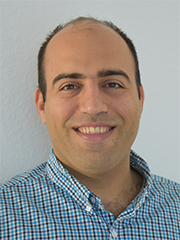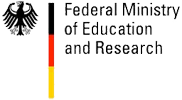| Foto | First Name | Last Name | Position |
|---|---|---|---|
 |
Mykhaylo | Andriluka | People Detection and Tracking |
 |
Roland | Angst | Vision, Geometry, and Computational Perception |
 |
Tamay | Aykut | |
 |
Vahid | Babaei | |
 |
Pierpaolo | Baccichet | Distributed Media Systems |
 |
Volker | Blanz | Learning-Based Modeling of Objects |
 |
Volker | Blanz | Learning-Based Modeling of Objects |
 |
Martin | Bokeloh | Inverse Procedural Modeling |
 |
Adrian | Butscher | Geometry Processing and Discrete Differential Geometry |
 |
Renjie | Chen | Images and Geometry |
Researcher
 |
Dr. Michael Zollhöfer |
Visual Computing, Deep Learning and Optimization
| Name of Research Group: | Visual Computing, Deep Learning and Optimization |
| Homepage Research Group: | web.stanford.edu/~zollhoef |
| Personal Homepage: | zollhoefer.com |
| Mentor Saarbrücken: | Hans-Peter Seidel |
| Mentor Stanford: | Pat Hanrahan |
| Research Mission: | The primary focus of my research is to teach computers to reconstruct and analyze our world at frame rate based on visual input. The extracted knowledge is the foundation for a broad range of applications not only in visual effects, computer animation, autonomous driving and man-machine interaction, but is also essential in other related fields such as medicine and biomechanics. Especially, with the increasing popularity of virtual, augmented and mixed reality, there comes a rising demand for real-time low latency solutions to the underlying core problems. My research tackles these challenges based on novel mathematical models and algorithms that enable computers to first reconstruct and subsequently analyze our world. The main focus is on fast and robust algorithms that approach the underlying reconstruction and machine learning problems for static as well as dynamic scenes. To this end, I develop key technology to invert the image formation models of computer graphics based on data-parallel optimization and state-of-the-art deep learning techniques. The extraction of 3D and 4D information from visual data is highly challenging and under-constraint, since image formation convolves multiple physical dimensions into flat color measurements. 3D and 4D reconstruction at real-time rates poses additional challenges, since it involves the solution of unique challenges at the intersection of multiple important research fields, namely computer graphics, computer vision, machine learning, optimization, and high-performance computing. However, a solution to these problems provides strong cues for the extraction of higher-order semantic knowledge. It is incredibly important to solve the underlying core problems, since this will have high impact in multiple important research fields and provide key technological insights that have the potential to transform the visual computing industry. In summer 2019 Michael Zollhöfer joined Facebook. |
Researcher
- Name of Researcher
- Michael Wand
- Homepage of Research Group
- First Name
- Michael
- Last Name
- Wand
- Foto

- Homepage
- www.staff.uni-mainz.de/wandm/
- Phone
- Position
- Statistical Geometry Processing
- Mentor in Saarbruecken
- Hans-Peter Seidel
- Mentor in Stanford
- Leonidas guibas
- Categories
- Former Groups
- Research Mission
- The major goal of computer graphics is the creation of photo-realistic synthetic models of reality. Synthetic depictions of seemingly real entities are of utility in various different applications, ranging from electronic prototypes of engineering parts to surreal virtual sets in fantasy movies. Today, computer graphics has already reached an impressive state-of-the-art: For example, it is commonplace that substantial parts of major feature films consist of synthetic renderings. However, the major bottleneck in today's content production pipeline is still the effort of the human designer: In order to create believable, photo-realistic models, three-dimensional data sets of enormous complexity have to be built, which requires much manual labor of highly-skilled experts. Thus, modeling costs (rather than costs of computational resources) is the main barrier that often still prevents the application of computer graphics techniques. The objective of this research group is the development of high-level modeling techniques that permit creation and editing of complex three-dimensional models at a high level of abstraction. The goal is to provide tools to the modeler that operate closer to the semantic domain than traditional low-level modeling techniques (which rather operate in the geometric domain). To be able to support a more abstract approach to modeling, the software must to some limited extend "understand" the structure of the models. The idea is to employ techniques from statistical data analysis and machine learning to "learn" the structure of aspects of example models in order to instantiate them again later during editing. This process is performed in three steps: First, a formal statistical model of the aspect to be analyzed has to be set up. This could describe e.g. the correlation of local geometric features or describe a low-dimensional parameterization of the space of overall shape. Next, example data (e.g. previous models that does not fully met the demands of the modeler, or a data set from a 3d-scanner) is analyzed. The analysis retrieves an estimate of the probability distribution of the statistical model parameters. This knowledge then facilitates a re-instantiation of new models (or parts of models) with a likely (i.e. believable) structure. By applying this analysis to different aspects of the model (ranging from local geometric texture to overall shape), different tools can be devised that support editing of various aspects of the model. The primary goal of the described research is to create more productive modeling tools for editing scenes with a photo-realistic amount of details. A good high-level modeling tool must provide an algorithmic formalism for "understanding" model aspects. Therefore, as a side effect, the resulting statistical models could possibly also reveal some insight into the structure of real-world artifacts and their human perception. In 2013 Dr. Michael Wand accepted a faculty position at the university of Utrecht, The Netherlands. Since 2104 Michael Wand has a chair for visual computing at the University of Mainz.
- mission_rtf
- Name of Research Group
- Statistical Geometry Processing
Personal Info
- Photo

- Website, Blog or Social Media Link



